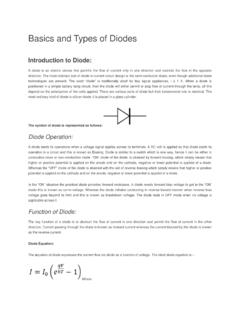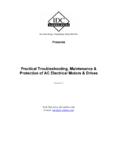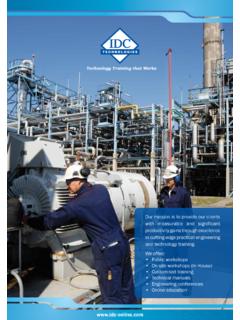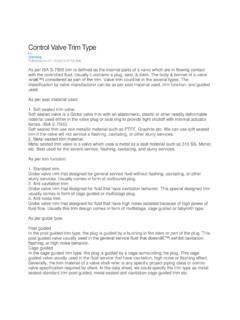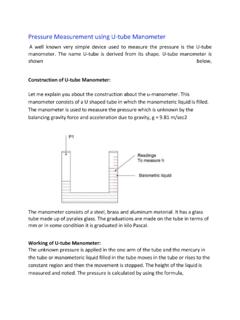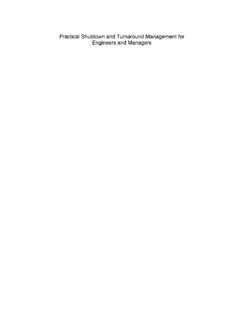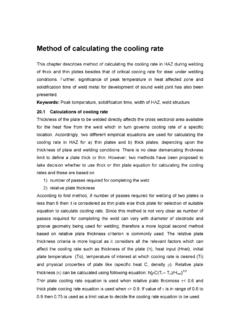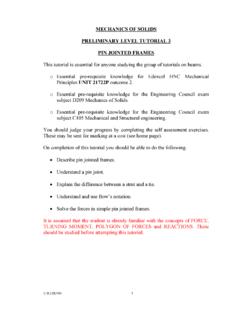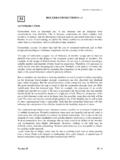Transcription of TYPES OF BOLTS UNFINISHED BOLTS - IDC-Online
1 TYPES OF BOLTST here are several TYPES of BOLTS used to connect the structural elements. Some of the BOLTS commonly used are: a) UNFINISHED BOLTS b) Turned BOLTS c) Ribbed BOLTS d) High strength BOLTS e) Interference BOLTS UNFINISHED BOLTS UNFINISHED BOLTS are also called ordinary, common, rough or black BOLTS . There are used for light structures (purlins, bracings, etc.) under static loads. They are not recommended for connections subjected to impact load, vibrations and fatigue. BOLTS are forged from low carbon rolled steel circular rods, permitting large tolerances.
2 Ordinary structural BOLTS are made from mild steel with square or hexagonal head, as shown in Fig (b). Square heads cost less but hexagonal heads give a better appearance, are easier to hold by wrenches and require less turning space. The bolt hole is punched about more than the bolt diameter. The nuts on BOLTS are tightened with spud wrenches, producing little tension. Therefore, no clamping force is induced on the sections jointed. Sometimes a hole is drilled in the bolt and a cotter pin with a castellated nut is used to prevent the nut from turning on the bolt , as shown in Fig (c). the connections with UNFINISHED BOLTS are designed in a similar way as all the riveted connections except that the permissible stresses are reduced to account for tolerances provide on shank and threaded portion of the BOLTS .
3 The requirements regarding pitch and edge distance are same as that for rivets. The permissible stresses are as given in Table of :800-1984. TURNED BOLTS These are similar to UNFINISHED BOLTS , with the differences that the shank of these BOLTS is formed from a hexagonal rod. The surfaces of the BOLTS are prepared carefully and are machined to fit in the hole. Tolerances allowed are very small. These BOLTS have high shear and bearing resistance as compared to UNFINISHED BOLTS . However, these BOLTS are obsolete nowadays. The specifications for turned BOLTS are given in :2591-1969. RIBBED BOLTS These are also called fluted BOLTS .
4 The head of the bolt is like a rivet head. The threaded and nut are provided on the other end of the shank. From the shank core longitudinal ribs project making the diameter of the shank more than the diameter of the hole. These ribs cut grooves into the connected members while tightening and ensure a tight fit. These BOLTS have more resistance to vibrations as compared to ordinary BOLTS . The permissible stresses for ribbed are same as that for rivets. HIGH STRENGTH bolt These BOLTS are called friction grip BOLTS . These are made from bars of medium carbon steel. Their high strength is achieved through quenching and tempering processes or by alloying steel.
5 Steel washers of hard steel or carburized steel are provided as shown in (d), to evenly distribute the clamping pressure on the bolted member and to prevent the threaded portion of the bolt from bearing on the connecting pieces. If the BOLTS are tightened by the turn of nut method, the nut is made snug and is tightened a half turn more by hand wrenches, then the washers are not required. The vibrations and impact resistance of the joint is also improved. The nut and head of the BOLTS are kept sufficiently large to provide an adequate bearing area. The specifications for high strength BOLTS are laid in :3757-1972 and : 4000-1967.
6 These BOLTS have a tensile strength several times that of the ordinary BOLTS . High strength BOLTS have replaced rivets and are being used in structures, such as high rise buildings, bridges, machines etc. Due to their distinct advantages and vital use, high strength BOLTS are discussed below in some detail. Advantages of high strength BOLTS High strength friction grip (HSFG) BOLTS have replaced the rivets because of their distinct advantages as discussed below. However, the material cost is about 50% greater than that of ordinary BOLTS and special workmanship is required in installing and tightening these BOLTS . 1. These provide a rigid joint.
7 There is no slip between the elements connected 2. Large tensile stresses are developed in BOLTS , which in turn provide large clamping force to the elements connected. High frictional resistances is developed providing a high static strength the joint. 3. Because of the clamping action, load is transmitted by friction only and the BOLTS are not subjected to shear and bearing. 4. The frictional resistance is effective outside the hole and therefore lesser load is transmitted through the net section. Thus, the possibility of failure at the net section is minimized. 5. There are no stress concentrations in the holes; therefore, the fatigue strength is more.
8 6. The tension in BOLTS is uniform. Also the BOLTS are tensioned up to proof load hence; the nuts are prevented from loosening 7. Few persons are require to make the connections, thus cost is reduced. 8. Noise nuisance is not there as these BOLTS are tightened with wrenches. 9. The hazard of fire is not there and there is no danger of tossing of the bolt . 10. Alterations can be done easily. 11. For some strength, lesser number of BOLTS are required as compared to rivets which brings overall economy. Principles of high strength BOLTS The shank of the high strength BOLTS does not fully fill the hole. So shear and bearing are not the criteria for load transmission as is in the case of rivets, which fill the hole completely.
9 The nut is tightened to develop a clamping force on the plates which is indicated as the tensile force T in the bolt . This tension should be about 90% of proof load. When a shear load is applied to the joint no slip will occur until the shear load exceeds the frictional resistance between the elements jointed. When shear load exceeds the frictional resistance a slip occurs. On further increase of this load, the gradual slipping brings the bolt in contact with the plate edges. The horizontal frictional forces F, is induced in the joints which is equal to the tensile force T, as in (d), in the BOLTS multiplied by the coefficient of friction.
10 F = T This frictional force F should exceed the applied force P on the member. = Coefficient of friction or slip factor, is defined as ratio of the load per effective interface required to produce slip in a pure shear joint to the proof load induced in bolt . When the element surfaces are free from paint, dust, etc. its value is
